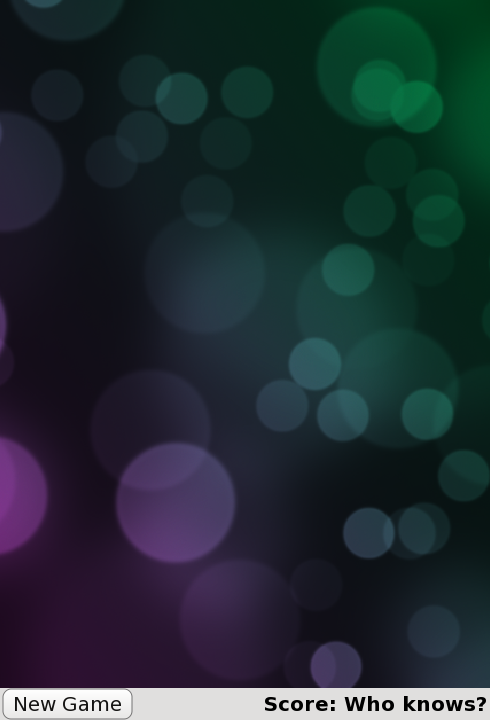QML 高级教程 1 - 创建游戏画布和方块#
创建应用屏幕#
第一步是创建您应用中的基本 QML 项目。
首先,我们创建一个类似于这样的主屏幕的 Same Game 应用程序
这是由主应用程序文件 samegame.qml 定义的,其外观如下
import QtQuick Rectangle { id: screen width: 490; height: 720 SystemPalette { id: activePalette } Item { width: parent.width anchors { top: parent.top; bottom: toolBar.top } Image { id: background anchors.fill: parent source: "pics/background.jpg" fillMode: Image.PreserveAspectCrop } } Rectangle { id: toolBar width: parent.width; height: 30 color: activePalette.window anchors.bottom: screen.bottom Button { anchors { left: parent.left; verticalCenter: parent.verticalCenter } text: "New Game" onClicked: console.log("This doesn't do anything yet...") } Text { id: score anchors { right: parent.right; verticalCenter: parent.verticalCenter } text: "Score: Who knows?" } } }
这为您提供了一个基本的游戏窗口,包括方块的主画布、一个“新游戏”按钮和一个计分显示。
你可能在这里不认识的一个项目是 SystemPalette 项目。这提供对 Qt 系统调色板的访问,并用于给按钮带来更本地的外观和感觉。
请注意,使用分组(点)标记设置了 Item、Button 和 Text 类型的锚点,以提高可读性。
和“方块”
组件#
如上代码中的 Button 项在名为 Button.qml 的单独组件文件中定义。为了创建一个功能按钮,我们在一个 Rectangle 中使用 QML 类型 Text 和 MouseArea 来创建一个按钮。以下是 Button.qml 的代码
import QtQuick Rectangle { id: container property string text: "Button" signal clicked width: buttonLabel.width + 20; height: buttonLabel.height + 5 border { width: 1; color: Qt.darker(activePalette.button) } antialiasing: true radius: 8 // color the button with a gradient gradient: Gradient { GradientStop { position: 0.0 color: { if (mouseArea.pressed) return activePalette.dark else return activePalette.light } } GradientStop { position: 1.0; color: activePalette.button } } MouseArea { id: mouseArea anchors.fill: parent onClicked: container.clicked(); } Text { id: buttonLabel anchors.centerIn: container color: activePalette.buttonText text: container.text } }
这基本上定义了一个包含文本并可被点击的矩形。MouseArea 有一个 onClicked() 处理器,当区域被点击时,该处理器将发射 clicked() 信号。
在 Same Game 中,游戏开始时屏幕被小块填充。每个方块只是一个包含图像的项目。方块代码定义在一个单独的 Block.qml 文件中
import QtQuick Item { id: block Image { id: img anchors.fill: parent source: "pics/redStone.png" } }
目前,方块没有做任何事情;它只是一个图像。随着教程的进行,我们将给方块添加动画和行为的操作。我们还没有添加创建方块的代码;我们将在下一章中做这件事。
我们使用 anchors.fill: parent 将图像设置为与父 Item 的大小相同。这意味着当我们在教程的后半部分动态创建和调整块项目的大小时,图像会自动缩放到正确的尺寸。
请注意,图像类型的 source 属性的相对路径。此路径相对于包含图像的 Image 类型文件的位置。作为替代,您也可以将图像源设置为包含图像的绝对文件路径或 URL。
您应该熟悉到目前为止的代码。我们只是创建了一些基本的类型以开始。接下来,我们将用一些方块填充游戏画布。
